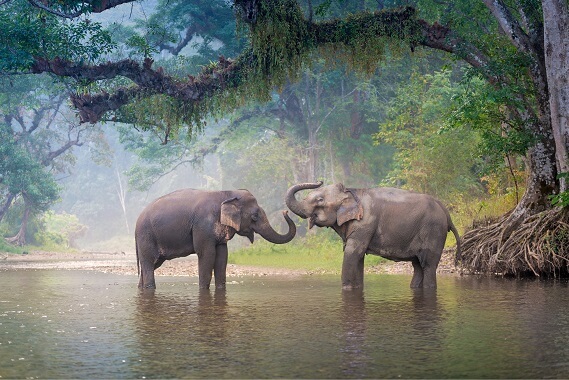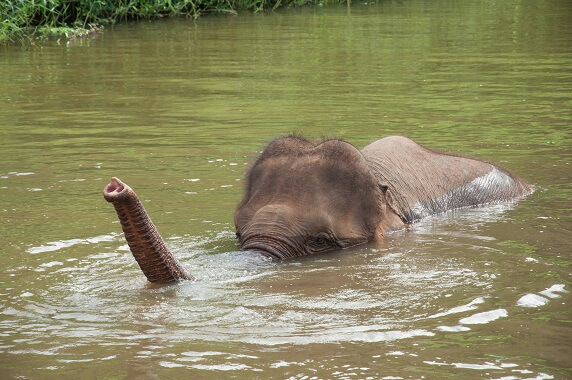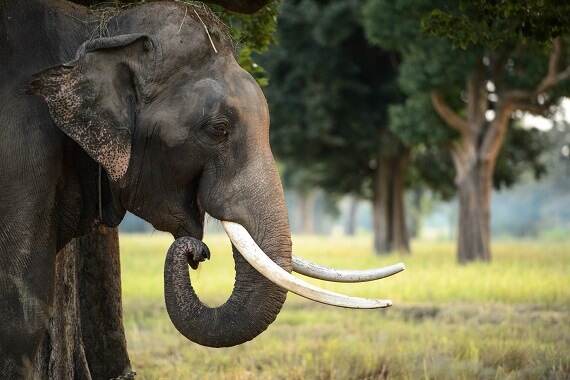
The Asian elephant (Elephas maximus) is found in forest and grassland habitats across the Asian continent. It is the largest land mammal in Asia and is currently found in 13 countries in South and Southeast Asia. It is slightly smaller than the African elephant. Elephants have grey skin, except in certain areas where lighter skin patches are found due to de-pigmentation. Lighter skin patches are most commonly found on the ears, trunk, and head. An elephant’s skin is thick in most places except the ears which are covered by paper-thin skin. The thickness of the skin can vary, for example, the skin on an elephant’s back can be up to 1 inch (2.54 cm) thick! The skin of an Asian elephant is extremely sensitive because it has a rich nerve supply. During hot days, the elephants will cover themselves with mud, sand, and dirt to protect their skin from the harmful rays of the sun as well as from several bugs. Another way that elephants cool down is by flapping their ears. Elephants have large ears that are covered by thin skin and contain a lot of blood vessels. Flapping their ears helps them to cool down as heat is lost from the blood vessels that are close to the surface of the skin. An elephant’s skeleton is built to support its large body, as well as to provide it with good mobility and strength. Unlike most mammals, an elephant’s bones are dense and perforated and do not contain a narrow cavity in the middle. The dense, perforated bones are stronger and can withstand more pressure than the bones of other mammals. Their skeletal shape is also different from other mammals. Instead of having angular legs, their legs are stacked underneath their body which provides more support to their large frame. The vertical position of the legs can support their great weight and allow them to remain standing for a long time without using too much energy. Several characteristics distinguish the Asian elephant from its African cousin. The easiest way to tell them apart is by looking at their ears. Asian elephants have rounded ears whereas the African elephant has ears that are the shape of the African continent. An Asian elephant’s ears and head are also much smaller than their African counterparts. Not only are their heads smaller but they are also a different shape – African elephants have a rounded head with a single dome, whereas Asian elephants have two domes with an indent between them. Another difference is that both male and female African elephants have tusks, but in Asian elephants only some of the males have them. Asian elephants are herbivores and may spend up to three-quarters of their day eating. They feed mainly on grasses, but also eat a large amount of smaller plants and tree bark. Some of their favorite foods are crops such as bananas, rice, and sugarcane. While these elephants prefer certain foods, they have adapted to eat a wide variety of vegetation depending on the area that they inhabit. Asian elephants are usually found close to a source of freshwater as they need to drink at least once a day. These elephants are extremely sociable and form herds. These herds are made up of six to seven related females that are led by the oldest female known as the matriarch. Sometimes these groups will join to form larger herds for a short time. Asian elephant herd sizes are considerably smaller than those of the elephants found in Africa. While the female elephants form herds that consist of only female elephants and calves, the males live in isolation or small bachelor groups. Asian elephants reach sexual maturity between the ages of 8 and 13. While the females will often have their first calf in their teens, the males usually don’t father offspring until much later in their lives. Behavioral studies suggest that males are more likely to mate in their 30s when they are bigger and strong enough to compete with other males. A female’s pregnancy lasts between 21.5 and 22 months, which is the longest gestation period for any animal. These elephants usually have one calf but on occasion two will be born. A calf weighs between 150 and 350 pounds (68 – 158 kilograms) and can stand shortly after its birth. The calves are nursed by their mothers until around 6 months of age when they begin to feed on vegetation. They also eat their mother’s dung for the first few years! The dung is highly nutritious and also contains bacteria that help the elephant’s to digest cellulose. Females will have a calf every three to eight years depending on the environmental conditions. A calf can stay nursing from the mother until a new calf is born. If the calf is male it will leave the herd once it reaches sexual maturity. Females remain with their families throughout their lives. The main threats to these elephants are habitat loss and conflict with humans. As human settlements expand, the elephant’s habitat shrinks and often becomes fragmented. This can lead to an overlap between the human and elephant habitats which can often result in confrontation. Elephants often raid human settlements stealing crops and destroying homes which, unfortunately, sometimes also results in human deaths. People often retaliate against these raids by killing the elephants. These confrontations are the leading cause of elephant deaths in Asia. Elephants are also captured from the wild and sold, with a large number going to Thailand where they are used in the tourism industry. Fortunately, India, Vietnam, and Myanmar have banned the capture of elephants to protect their wild populations. However, in Myanmar elephants are still taken each year to be used in the timber industry. Asian elephants are the largest land mammal in Asia! These social giants are most famed for their trunks which are an amazingly versatile tool. Elephants have some amazing biological adaptations that have enabled them to persist in their environments. Let’s take a closer look at some of these. An elephant’s trunk is its most versatile tool and can be used for breathing, touching, smelling, grabbing, and producing sound! The trunk is a fusion of the nose and the upper lip and it is composed mostly of muscles and contains no bones! Cartilage is found at the base of the trunk only, where it divides the nostrils. An elephant’s trunk has up to 40,000 muscles! When you compare this to the 639 muscles found in the entire human body, you can understand just how muscular these organs are! The trunk is also very powerful and can easily lift heavy objects. The trunk is so strong that it can lift 770 lbs! The Asian elephant has to wrap its truck around objects to move them as the trunk only has one finger. This differs from the African elephant’s trunk that has two fingers which is can pinch together to grab things. Elephants also use their trunks to smell. Due to a high number of receptors in its nasal cavity, the elephant has an amazing sense of smell that is reportedly four times great than that of a bloodhound. Their sense of smell is so strong that they can reportedly smell water that was several miles away. Aside from its use in smelling and moving objects, an elephant’s trunk also has some interesting uses. Elephants use their trunks to make noises and greet other elephants and so they are useful as a tool of communication. They can be used to guide baby elephants, offer comfort to herd members, and to smell other elephants to gain information about then. An elephant may also use its trunk like a snorkel, extending it above them as they move through deep water which enables them to cross large rivers and deep water bodies. Asian elephants have six sets of teeth at birth. The first set of teeth is very small, with each set after that gaining in size and complexity and lasting longer than the set that came before it. To accommodate larger teeth, an elephant’s skull continues to grow throughout its lifetime. As an elephant gets older, its teeth become worn. So that the new teeth can be used, the old teeth move forward and break or fall out of the mouth or are swallowed. Researchers can estimate an elephant’s age by examining their teeth. The number of sets of teeth an elephant has left and how worn they are can provide information about how long it has been alive. Tusks are modified teeth that continue to grow throughout an elephant’s life. Only some male Asian elephants will have tusks. Tusks are an elephant’s upper incisors and are made of ivory which is similar to bone. Ivory is made mostly of calcium and phosphate. The tusk that you see is only two-thirds of it, the remaining one-third is embedded in a socket in the elephant’s head. Elephants walk on tiptoes, resting the majority of their weight on the tips of their toes and a pad under their heel. This pad is thick and fibrous and acts as a shock absorber, protecting the bones in their legs and toes from damage by cushioning each step. As the elephant moves, the sole of its feet spread out to help take the weight of this massive animal. The way these elephants walk is why they make very little sound when they move.
Kingdom
Animalia
Phylum
Chordata
Class
Mammalia
Order
Proboscidea
Family
Elephantidae
Genus
Elephas
Species
Elephas maximus
Height
6.5–11.5 feet (2 – 3.5 meters)
Length
Up to 21 feet (6.4 meters)
Weight
11,000 lbs (4,989.5 kg)
Lifespan
60 – 80 years
Social Structure
Social, live in herds
Status
Endangered
Preferred Habitat
Forests
Average Litter Size
1
Main food item
Plants, grasses, and roots
Main threats
Humans, deforestation, and habitat destruction
The Basics!
Characteristics
Habitat and Feeding

Reproduction
Threats
Fun Facts about the Asian Elephant!
A Muscular Nose

Six Sets of Teeth

Walking on Tiptoes
